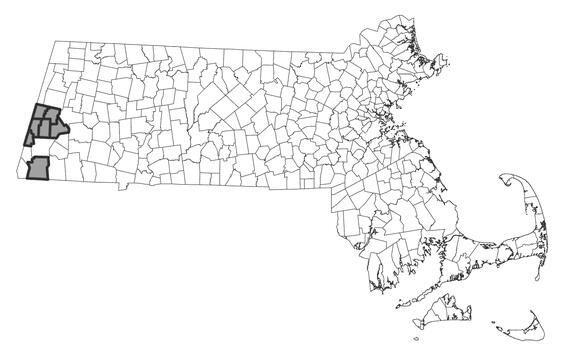- Scientific name: Galium labradoricum (Wiegand) Wiegand
- Species of Greatest Conservation Need (MA State Wildlife Action Plan)
- Threatened (MA Endangered Species Act)
Description
Labrador bedstraw (Galium labradoricum) is a slender perennial herb of the madder family (Rubiaceae), known in Massachusetts from calcareous wetlands. Growing to 10-40 cm (4-16 in) in height, this plant has multiple whorls of linear leaves in fours distributed along a slender stem, with a dense hairy beard at each node. The leaves are relatively short (8-15 mm [0.3-0.6 in]) and narrow (mostly 1-2.5 mm [0.04-0.1 in]) with one nerve. They are spreading to slightly recurved downward and have margins that are coarsely hairy (hispidulous). The inflorescences are primarily terminal, branched up to two times, with three white four-petaled flowers, 2-3 mm (0.08-0.12 in) wide.
- Plants up to 40 cm (16 in) in height
- Leaves whorled in fours each with one nerve
- Dense hairy beard at the leaf nodes
- Spreading or recurved leaves with hispidulous margins, usually glabrous midrib
- White flowers with four petals, in cluster of three on terminal inflorescences
There are five other bedstraw species that have one-nerved leaves whorled in fours that could occur in calcareous fens in Massachusetts, but each has other characters that can be used to differentiate it from Labrador bedstraw. Marsh bedstraw (G. palustre) has a more highly branched inflorescence that bears at least five flowers. Three other species, Clayton’s marsh-bedstraw (G. tinctorium), northern three-lobed bedstraw (G. trifidum), and short-stalked bedstraw (G. brevipes), all have three-petaled flowers. Further, these species lack a dense hairy beard at the nodes. Blunt-leaved bedstraw (G. obtusum), the species most similar to Labrador bedstraw, does have hairy nodes, but its leaves are generally larger than the rarer bedstraw (10-30 mm × 1-6 mm [0.4-1.2 x 0.04-0.24 in] wide), are ascending to spreading (not deflexed), and can have coarse hairs on the underside along the midrib in addition to the margin. Also, an overall larger plant, blunt-leaved bedstraw can be up to 80 cm (31.5 in) in height.
Life cycle and behavior
Labrador bedstraw is a perennial plant that flowers mid-May to mid-June. Its pollinators are not known. Ripe fruits are present from late June through the end of August. Its fruits are smooth and it is assumed that they fall near the parent plant, no known mechanism for dispersal is known.
Population status
Labrador bedstraw is listed under the Massachusetts Endangered Species Act as threatened. All listed species are protected from killing, collecting, possessing, or sale and from activities that would destroy habitat and thus directly or indirectly cause mortality or disrupt critical behaviors. There are eight populations in Berkshire County that have been verified since 1999.
Distribution and abundance
Labrador bedstraw occurs throughout all of Canada (except Yukon Territory), south to North Dakota and Iowa to New Jersey. It is rare in many of states at its southern extent. In New England, it critically imperiled in Connecticut and Vermont, imperiled in Maine and Massachusetts and it does not occur in New Hampshire or Rhode Island (NatureServe 2025).

Distribution in Massachusetts. 2000-2025. Based on records in the Natural Heritage Database.
Habitat
Labrador bedstraw inhabits calcareous fens, wet meadows, and swamps, often on hummocks or tussocks in full or filtered sunlight. Associated species include sphagnum mosses (Sphagnum spp.), lakeside sedge (Carex lacustris), inland sedge (Carex interior), cinnamon fern (Osmundastrum cinnamomeum), bog buckbean (Menyanthes trifoliata), shrubby cinquefoil (Dasiphora floribunda), tamarack (Larix laricina), red maple (Acer rubrum), black ash (Fraxinus nigra), alder-leaf buckthorn (Rhamnus alnifolia), silky dogwood (Cornus amomum), and willows (Salix spp.).
Healthy habitats are vital for supporting native wildlife and plants. Explore habitats and learn about conservation and restoration in Massachusetts.
Threats
Threats to Labrador bedstraw include competition and shading from native and exotic plants, flooding due to beaver activity, and anthropogenic changes to water quality (e.g., from road salt, nutrient inputs from fertilizers) or hydrologic regime. Habitats should be monitored periodically for invasive plants such as common reed (Phragmites australis ssp. australis) and purple loosestrife (Lythrum salicaria), and for competition or shading by native wood plants.
Conservation
If necessary, a plan for vegetation control should be constructed. Also, beaver activity should be noted and reported if habitat is in danger of being inundated. All active management of rare plant populations (including invasive species removal) is subject to review under the Massachusetts Endangered Species Act and should be planned in close consultation with MassWildlife’s Natural Heritage & Endangered Species Program.
References
Gleason, Henry A., and Arthur Cronquist. Manual of Vascular Plants of Northeastern United States and Adjacent Canada, Second Edition. Bronx, NY: The New York Botanical Garden, 1991.
Native Plant Trust. 2014. NORM Phenology Information.
NatureServe. 2025. NatureServe Network Biodiversity Location Data accessed through NatureServe Explorer [web application]. NatureServe, Arlington, Virginia. Available https://explorer.natureserve.org/. Accessed: 5/23/2025.
Contact
| Date published: | April 29, 2025 |
|---|